'A sad situation': Homeless campers prepare to leave BLM land as closure approaches
Tony Tozier is having a rough few weeks.
The 63-year-old's problems started in late December with a pain in his chest. When he finally sought medical care, hospital staff told him he was having a heart attack.
Days later, he returned to his tent on a patch of desert outside Goldfield Ghost Town, an 1800s-themed tourist attraction up the road from Apache Junction in Pinal County. Armed with four medications from his cardiologist, he planned to rest and recuperate.
Then, he got a paper notice. The area where he’s living is closing — and soon.
The land’s owner, the Bureau of Land Management, plans to convert it into a 1,100-acre recreation area. They want everybody out by 12:01 a.m. on Feb. 5.
The decision comes after years of local concerns about trash, illegal camping, and fire risks in the area, as well as increasing pressure for parking spaces near fast-growing metro Phoenix.
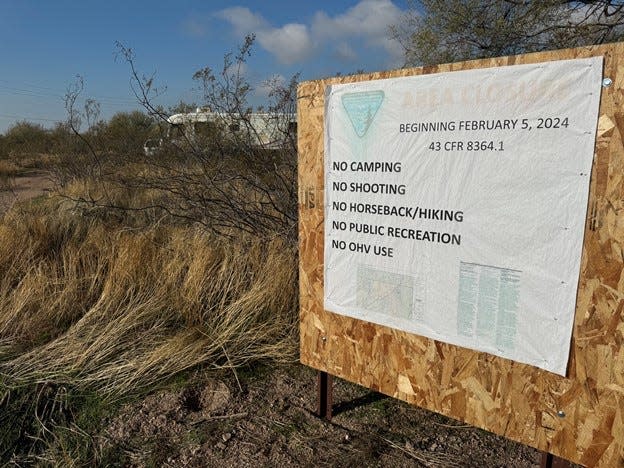
The land offers superb views of the Superstition Mountains, less than an hour away from the densely packed heart of the state. The new recreation area will offer trails for hiking, mountain biking and horseback riding, BLM spokesperson Chris Wonderly said. It will include amenities such as equestrian staging areas, hitching posts, picnic tables, toilets and signage, making the land usable for more people.
That compliments outdoor opportunities in nearby Tonto National Forest, Lost Dutchman State Park and Peralta Regional Park.
But some worry driving out the people who already live in the area could push them further into rural desert areas, putting them at increased risk of crime, dehydration and other dangers.
It's a dilemma similar to those playing out in urban areas, as government officials weigh public safety and possible neighborhood nuisances against displacing homeless people and moving them farther away from services.
Agency officials declined to specify exactly what will happen to people who remain in the area on the closure date. But they say rangers have the authority to cite or arrest for federal violations. Anyone who stays in the area past the deadline could be fined or imprisoned for up to a year under federal laws, according to a notice published in the federal register early last month.
“Each encounter is different, and our training provides BLM law enforcement professionals with the skills and knowledge they need to act with professionalism and compassion whenever possible and to stay safe and communicate effectively,” Wonderly said. “They will ensure the rules of the closure are enforced.”
Now, Tozier and his neighbors are trying to figure out where to go. At least a few dozen people live in tents, cars and campers scattered across the area, which has long served as a landing spot for people who need a place to stay.
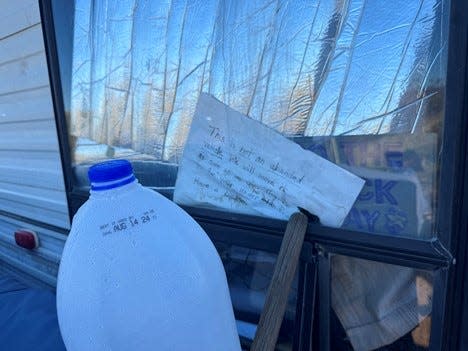
Most people interviewed by The Republic said they intend to leave before the deadline — even if they face struggles packing up their belongings and getting out.
Tozier wants to see his cardiologist one last time before he moves. He said he’s “not supposed to be doing a whole lot of anything” while he recovers, but he needs to get his Dodge Caravan in drivable condition to move elsewhere.
He plans to head west toward California, where he has family. He's hoping he makes it through the journey.
“I’ve got so much to do and so little energy to do it,” he said.
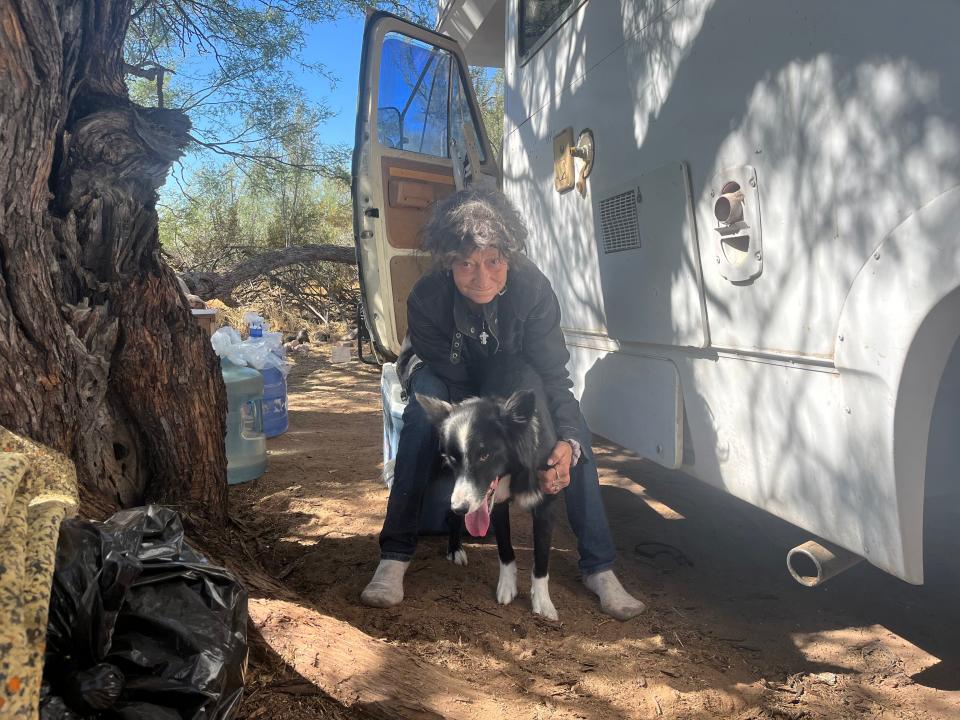
For many, barriers to leaving
Rose Sherwood, 69, and Bill Shelly, 58, also have a plan.
They’re going to rent a trailer and clean up the piles of trash they’ve picked up around their camping area. They’d like to leave the place “in better shape than it was when we got here.”
They also need to get their RV running. They have a laundry list of repairs on the camper before they leave, not to mention filling their tank with gas.
That will set them up to leave the day before the deadline. Eventually, they hope to make it to a patch of land they said they own near Kingman. That’s on the western side of the state, about 250 miles away.
There’s just one problem. Shelly said he and Sherwood are “dead broke.” Filling up their gas tank alone could cost hundreds of dollars — not to mention the cost of renting a trailer to take the trash to the dump and getting parts for their camper.
“I think we’ve got a dollar in the bank,” Shelly said. “We’re rich.”
It’ll be a lot of work, and they likely won’t have the gas to get far at first, they said.
But there aren’t many other options. If they can’t leave on their own before Feb. 4, they fear their RV could be towed — taking everything they own with it.
They're some of the lucky ones. Gina Barker, 51, lives in her car and said she has no idea where she'll end up. She hopes to find a local parking lot that won't kick her out.
“It’s a sad situation they’re putting us in,” she said.
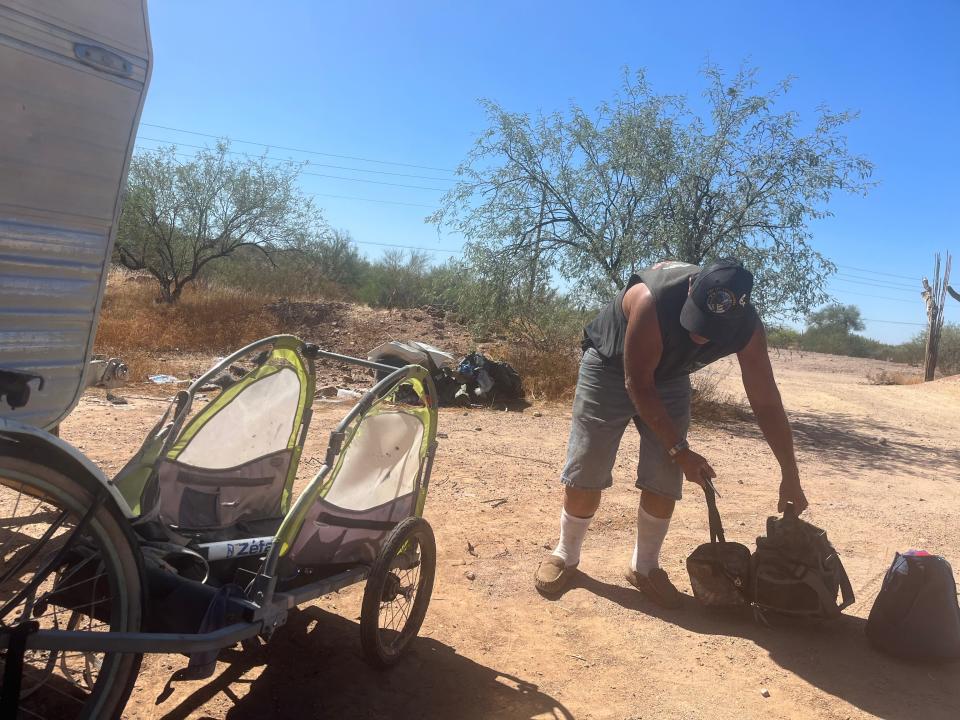
Usually, encampment clearouts are accompanied by offers of temporary housing and other support.
Phoenix officials, last year, cleared out blocks of camping tents, blue tarps and other makeshift shelters in "The Zone," the city's largest homeless encampment. Residents were offered indoor shelter options ranging from hotel rooms to beds in congregate shelters.
According to Phoenix's Office of Homeless Solutions, 585 of the 718 people who were offered resources during cleanings of the area were placed in an indoor shelter. As of last November, 68% of those people are still in shelters or receiving services.
In this clear-out, BLM officials said they will direct people living in the area to the Genesis Project, an Apache Junction soup kitchen, and Arizona's 2-1-1 social services hotline.
However, they won't directly offer shelter services, and Wonderly said he doesn't know where the Genesis Project or the 2-1-1 hotline will refer people for help.
The Republic tried to track down possible options by calling the 2-1-1 hotline. After a 45-minute hold time, a representative declined to comment on where individuals from the area might seek shelter. On 2-1-1’s website, there are no listed resources under “homeless shelters” in the directory for Pinal County.
That could be because there are none. Heather Patel of the Pinal County Coalition to End Homelessness said the only shelters she knows of in the county are specifically designed for domestic violence victims and veterans.
Neighboring Maricopa County does have shelter options and some other resources for homeless individuals. Dorothy Bolen, 62, has been searching for available hotel rooms across the county line in Mesa.
So far, she hasn't had any luck finding one.
Even if she does, she'll need to leave many of her belongings behind. Bolen is stuck moving on foot because she doesn't have a car, and she struggles to walk due to chronic pain in her back and knees. She doesn't expect she'll be able to carry much.
"I'm about to lose everything I own," she said. "I'm angry."
Nonetheless, Bolen said she will leave by the deadline.
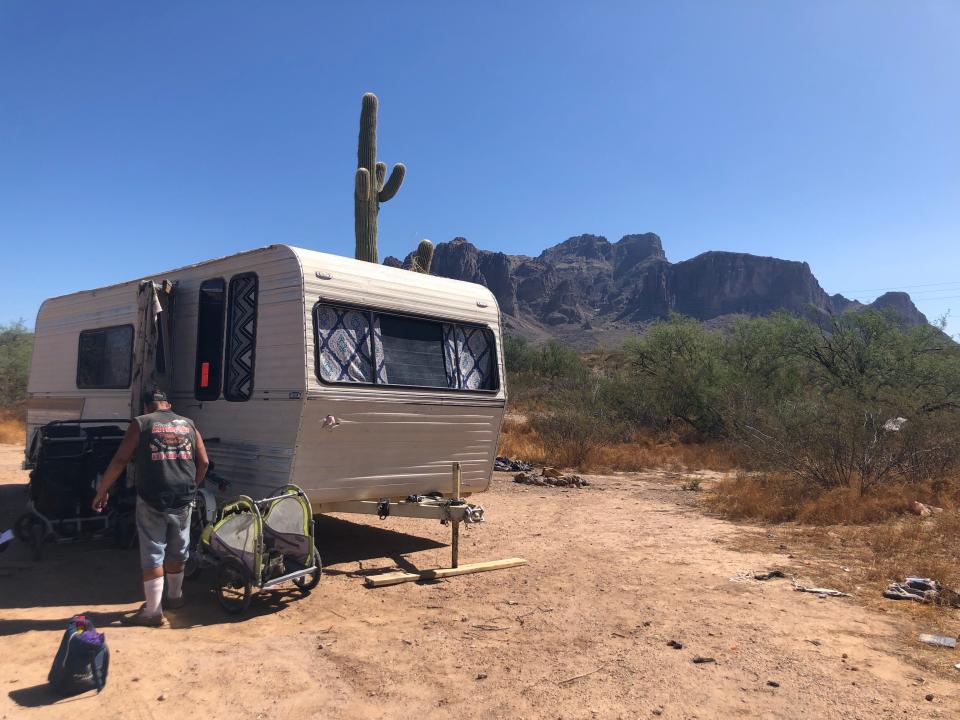
Situation sheds light on rural homelessness
Unlike their urban counterparts, America's growing population of rural homeless people is often less visible than those in cities. The Republic encountered more than a dozen people living in the closure area, including more tents, RVs and vehicles that can’t be seen from the road.
Local officials said it's nearly impossible to get a sense of the scale of homelessness in Pinal County. Its most recent point-in-time count shows just over 200 homeless people countywide. Experts believe that is a significant undercount.
Homeless individuals in rural areas also have access to far fewer resources, increasing the potential danger of moving further into the wilderness.
Most people encountered by The Republic in the closure area have been over the age of 50, making it harder for them to get to stores on foot for supplies and more at risk of needing medical assistance.
Available data suggests Pinal County's total homeless population may trend older than that of more urban Maricopa County. Nearly 60% of homeless individuals included in Pinal County's point-in-time count were over the age of 45. In Maricopa County, just under 40% of people identified in last year's point-in-time count were older than 45. That could be because some Valley cities offer more services catered to older adults experiencing homelessness.
Joan Terrall, 67, said she had heatstroke numerous times last summer.
Each time, an ambulance parked on the side of State Route 88. Paramedics walked through the desert brush to find her tent and escorted her back to the road for transport to the hospital.
Tozier, the man who had a heart attack, said he opted to have a friend drive him to the hospital as his chest got "harder" and "tighter" with each passing minute.
Shelly has chronic obstructive pulmonary disease, an illness that makes it difficult for him to breathe. He said ambulances can't get back to his campsite, either.
And many residents, including Terrall and Bolen, have to hitchhike to get food and water. The closest grocery stores are in Apache Junction, a few miles down the road.
"It's hard," Bolen said.
At least 19 homeless individuals died in Pinal County last year, according to data from the county's Medical Examiner's Office. Of those deaths, at least seven were related to chronic medical conditions, some exacerbated by heat or drugs.
At least two other deaths were directly caused by heat exposure, and about seven others were primarily due to drug use, per the data.
Sasha Hupka covers county government and regional issues for The Arizona Republic. Do you have a tip? Reach her at sasha.hupka@arizonarepublic.com. Follow her on X, formerly Twitter: @SashaHupka. Follow her on Instagram or Threads: @sashahupkasnaps.
Helen Rummel covers higher education for The Arizona Republic. Reach her at hrummel@azcentral.com. Follow her on X, formerly Twitter: @helenrummel.
This article originally appeared on Arizona Republic: Homeless campers prepare to leave BLM land as closure begins

